Last month SIG Ammunition delivered 825,000 rounds of their composite cased 6.8x51mm ammunition to the US Army for Prototype Test #2 of the Next Generation Squad Weapons program. This is in addition to earlier deliveries as part of the program as well as ammunition used for in-house development and testing. All told, I’d estimate they’re approaching over one million rounds of next generation hybrid cased ammunition.
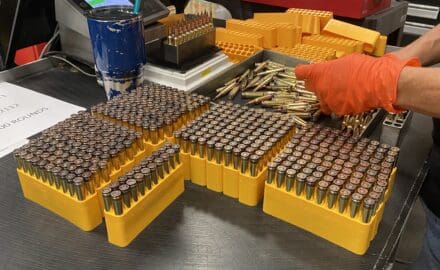
The NGSW program will replace the 5.56mm M4 Carbine and M249 Squad Automatic Weapon with a new Rifle and Automatic Rifle at the squad level in close combat formations like infantry and cavalry scouts. The other services are monitoring the program as well to decide if they want to participate.
In addition to the ammunition, NGSW-AR lightweight machine guns, and NGSW-R rifles mentioned above, the program also includes suppressors. Additionally, they are working on a dedicated Fire Control system with other vendor teams.
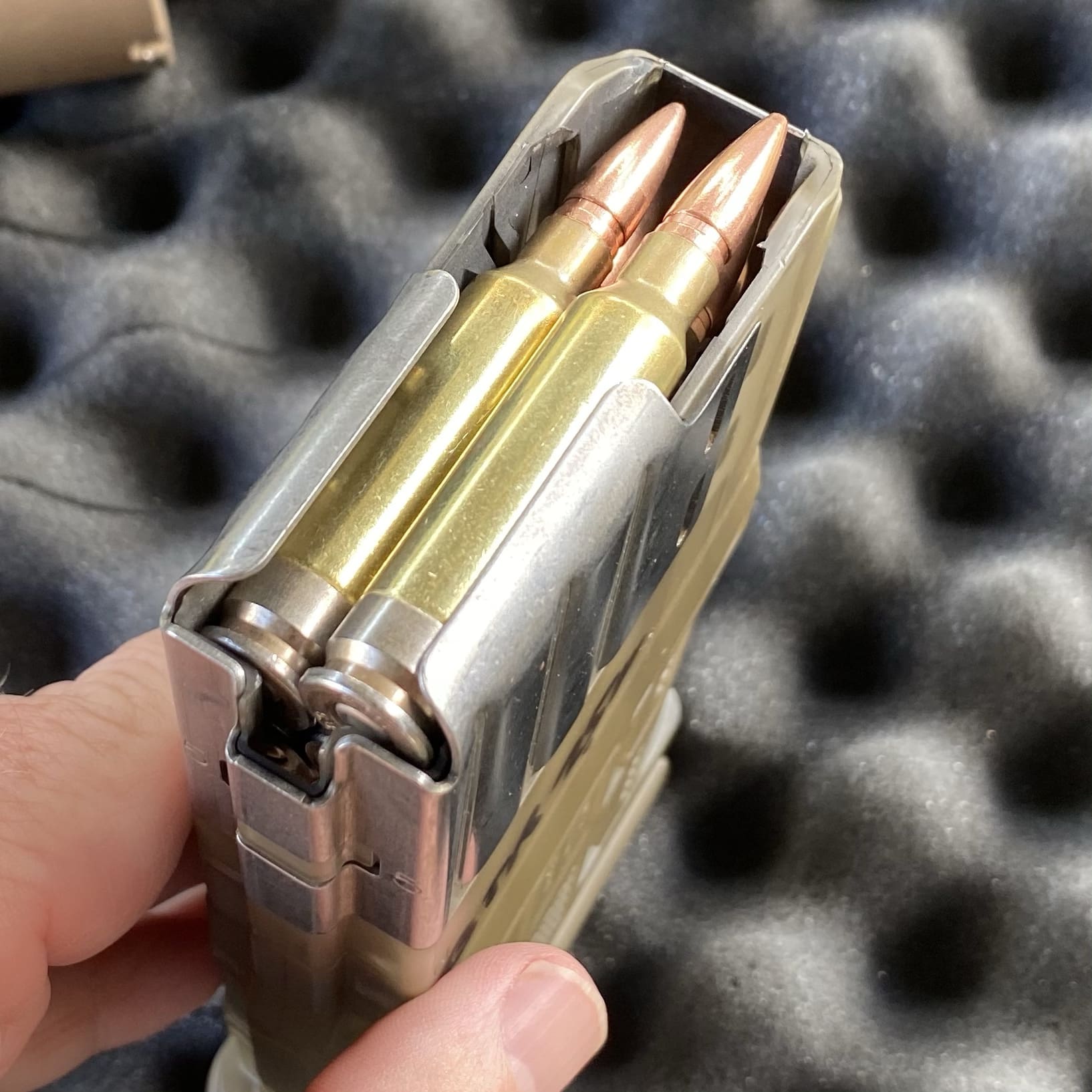
At the heart of this program is the ammunition. The Army gave industry a 6.8mm projectile and a performance specification, but left it up to them on how to best deliver that projectile within the required performance parameters.
Turns out, that performance they are seeking is similar to 270 Win Short Mag. The velocities required to achieve the desired effects for that 6.8mm projectile on target call for extremely high chamber pressures in excess of 80,000 psi; previously unheard of for small arms.
As if it wasn’t enough that the ammunition is a larger caliber than what it is replacing, it has to be at least 20% lighter as well. The SIG ammunition hybrid design beats that goal at 23.5% lighter than the weight of an equivalent energy cartridge (270 WSM). Below, you can see the hybrid case next to conventional all brass cased ammunition.
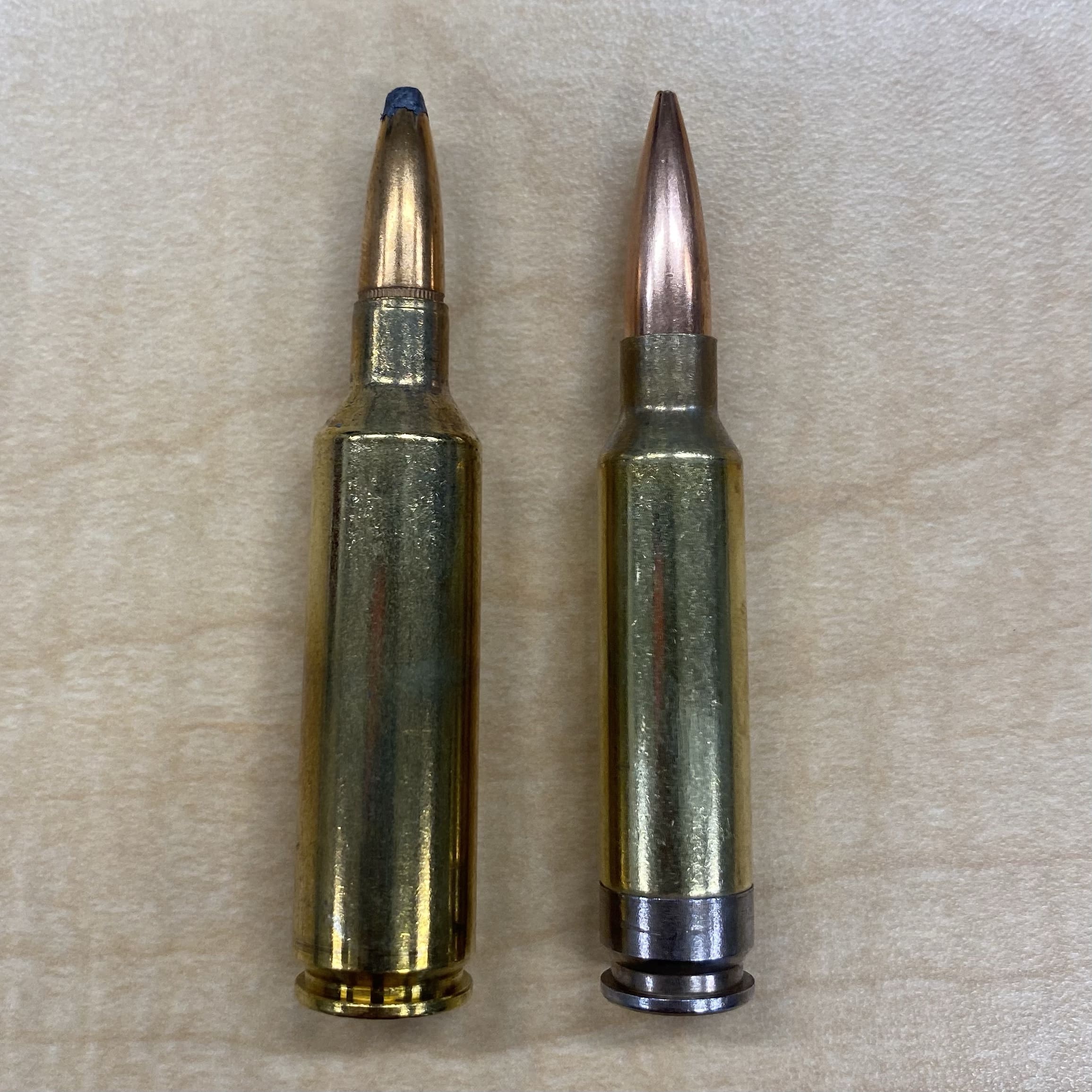
This is no science project. The Army plans to pick a solution by next year. While the engineering alone is daunting, industry has to also be able to actually manufacture the ammunition and weapons they’ve designed, in the event they are selected.
NGSW Candidates
The requirement has led to some interesting solutions. From an opening crowd of 16 industry teams offering various solutions, the Army narrowed it down to just three: SIG SAUER with their own hybrid cased ammunition consisting of brass body and steel head; General Dynamics-OTS teamed with True Velocity to introduce a recyclable polymer cased cartridge; and Textron Systems using a Case Telescoped cartridge which features a polymer case that completely encases the projectile and propellant, resembling a rimless shotgun shell. This slide depicts all of the candidate systems.
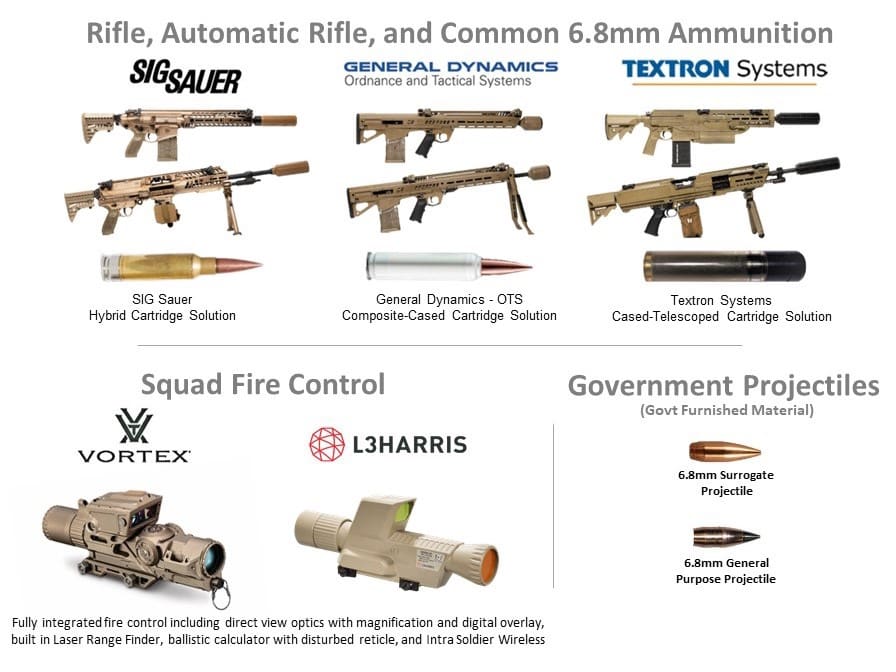
SIG’s Hybrid Case Ammunition Solution
SIG has been producing this ammunition in their Jacksonville, Arkansas factory. Last Fall, I had the opportunity to check out their operation. During the tour I witnessed manufacturing of commercial ammunition as well as the .300 WinMag ammunition under contract for the US Army and the new composite case rounds in 6.8x51mm for the NGSW program.

I’ll highlight their process for manufacturing the composite case at the time of my visit. Over time, it may change slightly due to regular upgrades in both processes and machinery. For example, when the cartridge case was first created, SIG used a three-piece design which included an internal aluminum lock washer to hold the head and case together. In the cutaway below you can see the washer in the three-piece design. Since then, they’ve refined it to a two-piece design which streamlines manufacturing and also saves even more weight and cost.
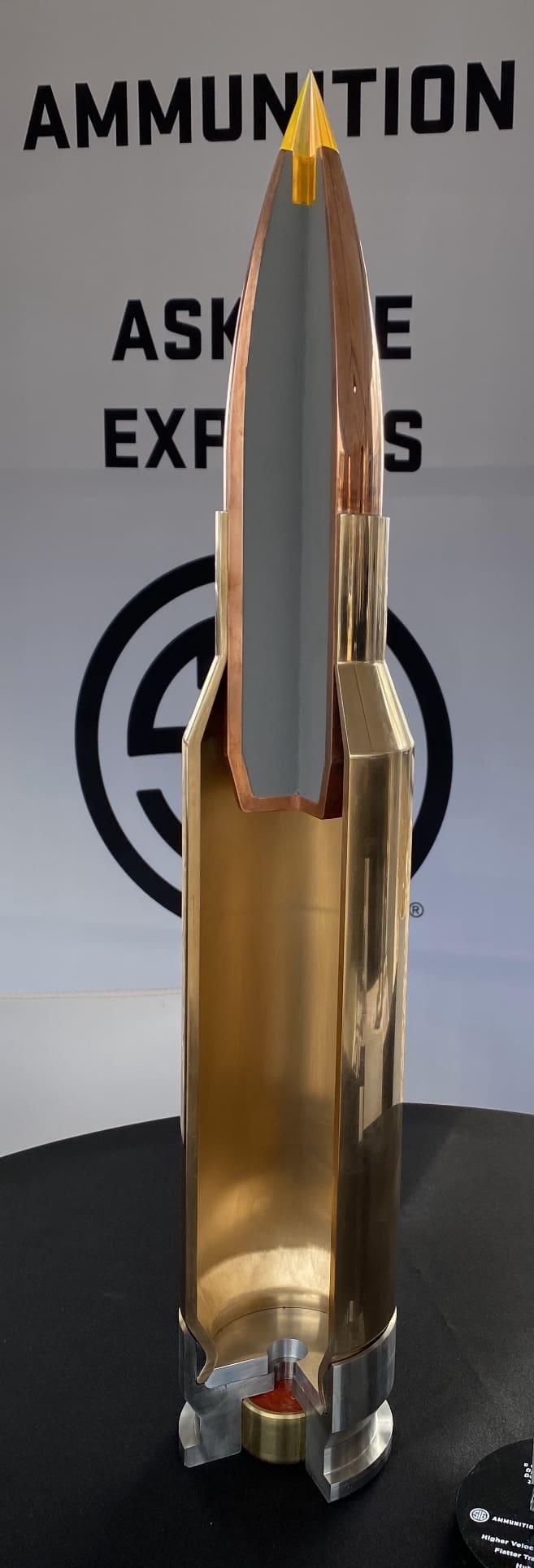
The hybrid design not only lowers weight compared to traditional all brass cased ammunition, but there are additional advantages as well. There is also more strength in the steel head where you need it, yet they retain the malleable brass case that works very well in the firing cycle. Forming the brass case body the way they do also means it is more uniform and they get an extra 200-300 feet per second muzzle velocity from the same load compared to conventional all brass case.
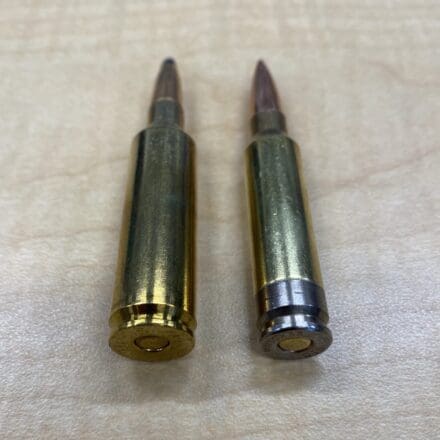
SIG Ammunition manufactures the hybrid case and complete round using the same types of machines used to manufacture all brass cased ammunition.
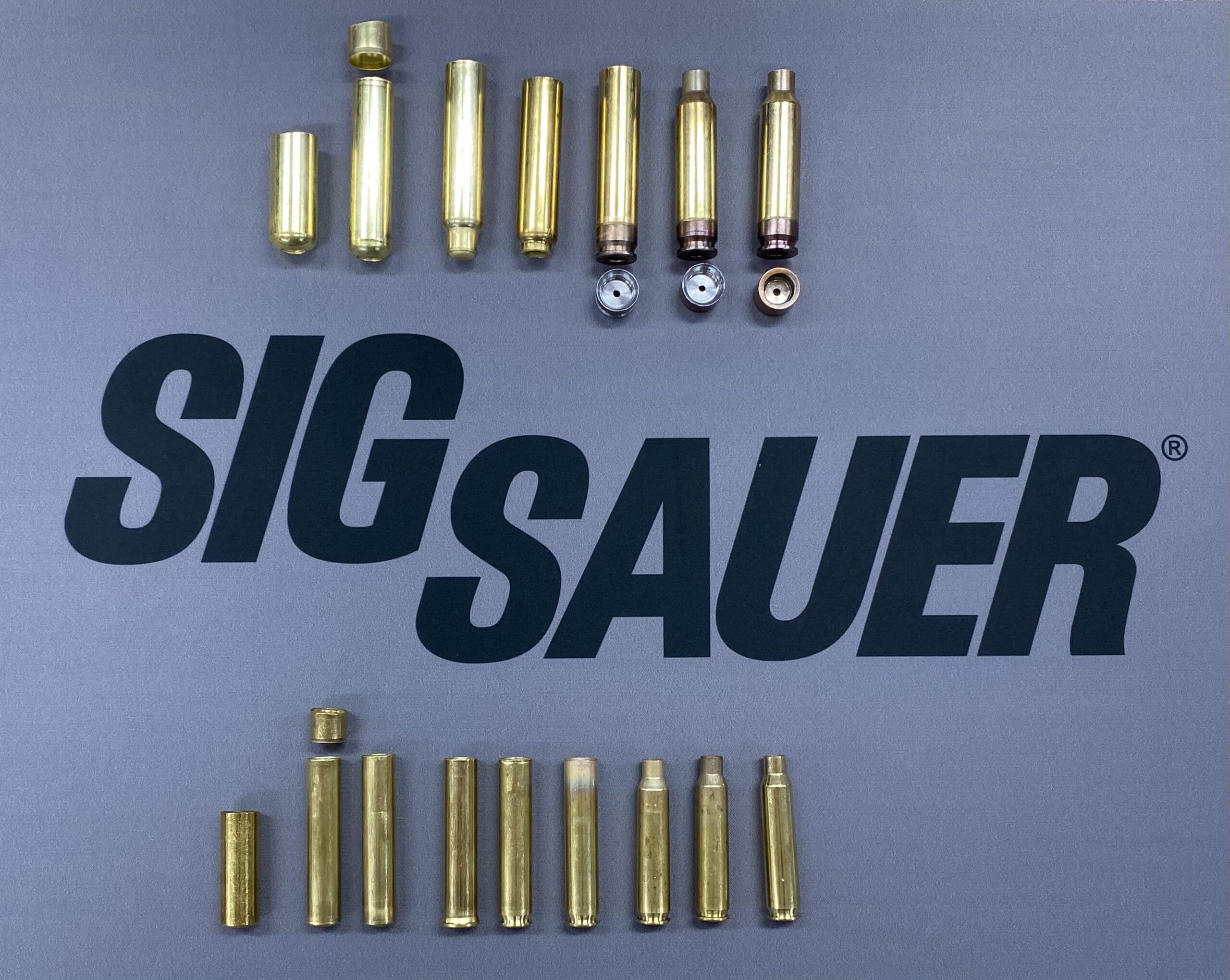
In this image you can see the processes to manufacture a conventional all brass 5.56mm case which is the lower set in the image.
1. Cup
2. Final Draw and Trim
3. Primer Pocket
4. Head Stamp
5. Pierce / Body Anneal
6. Taper
7. Mouth Anneal / Stress Relief
8. Polish / Final Inspect
With the hybrid case (upper set of cases), the steel head is manufactured separately and the case body and head are combined in a press. Otherwise, the processes are quite similar to conventional bass cased ammo.
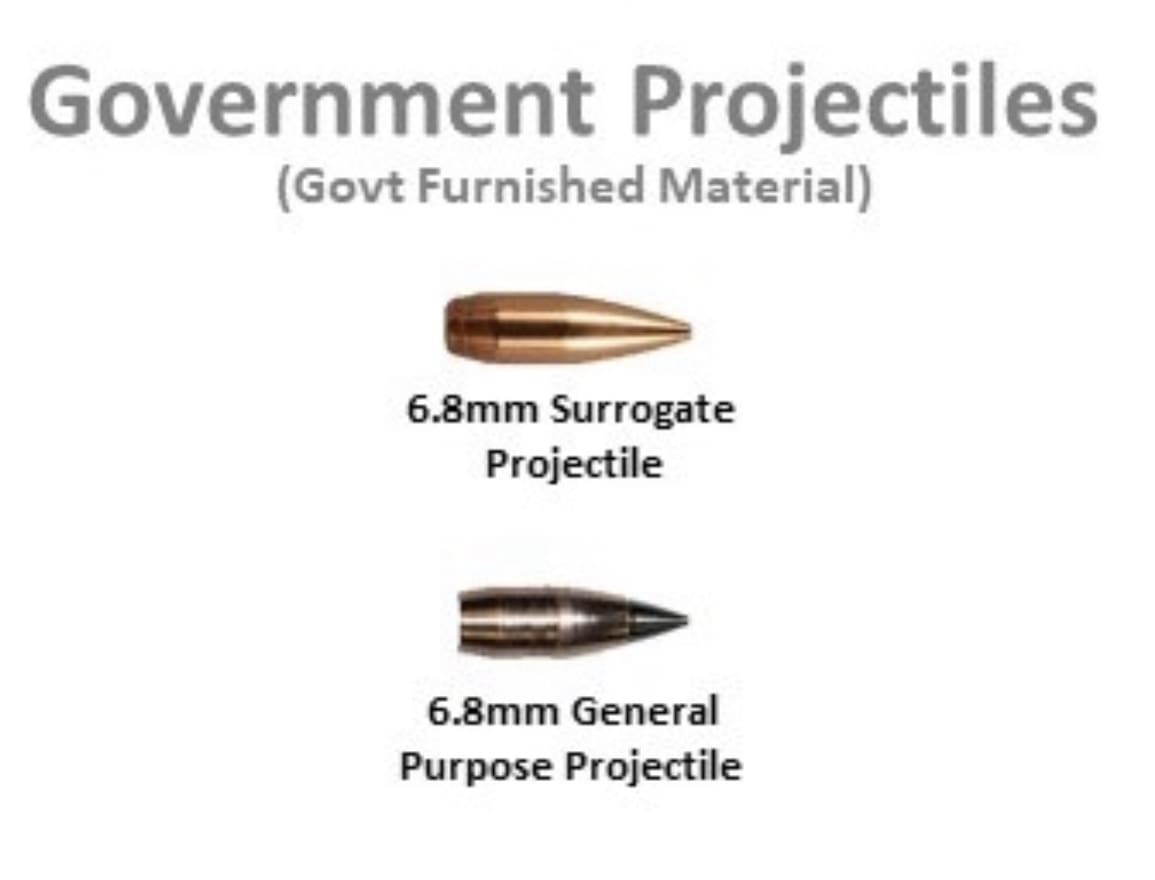
While SIG is working on their own primers, which are still a ways out, SIG uses commercial primers and propellants combined with government furnished projectiles to manufacture the 6.8x51mm next generation ammunition.
Commercial Applications
Never fear. While this ammunition was developed for NGSW, SIG is poised to offer a commercial version, called 277 SIG FURY.
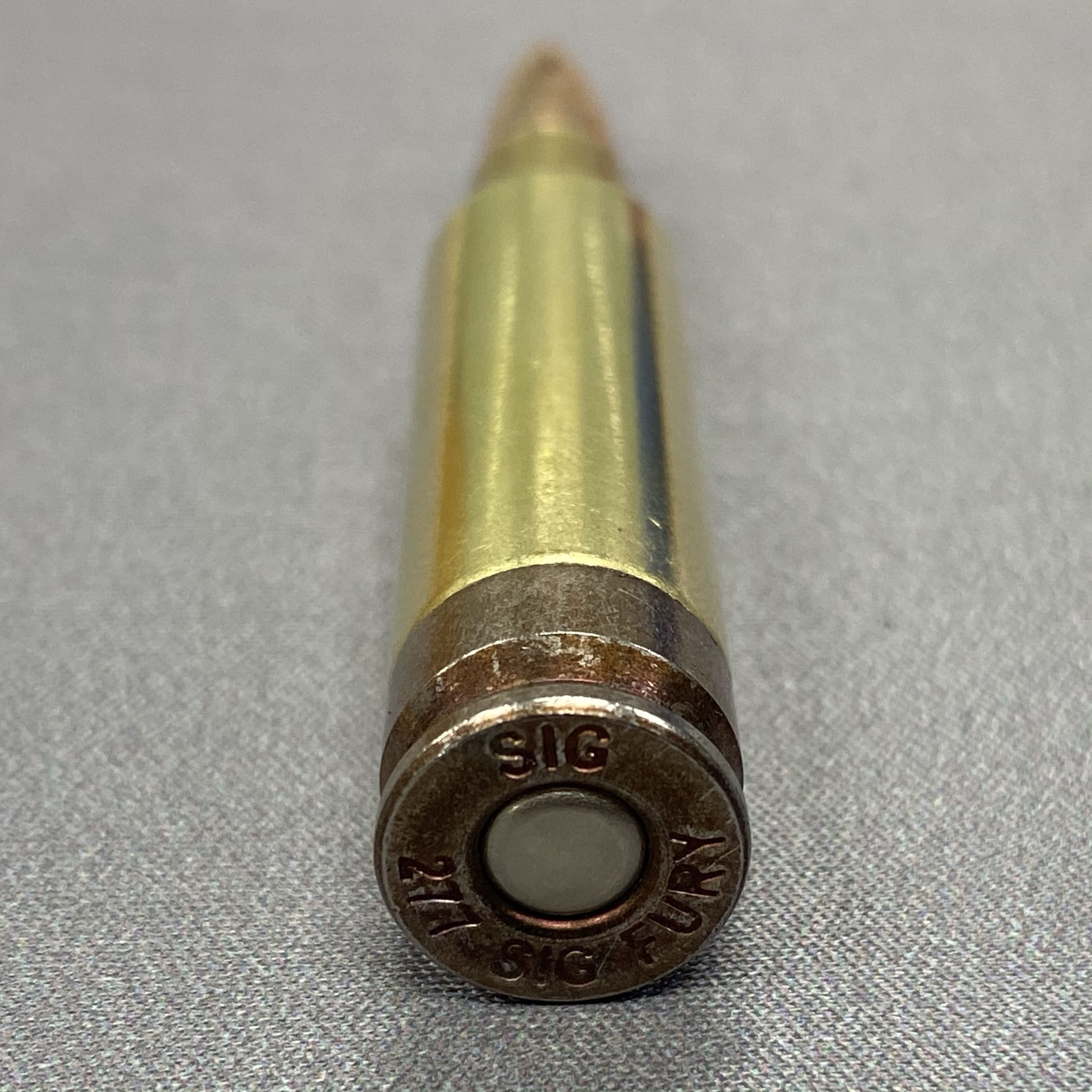
From the outset of the NGSW program SIG planned on offering this ammunition commercially to the consumer. During my visit Jason Imhoff, Director of Ammunition Engineering at SIG, related, “The thought of civilians not having access to a new military cartridge never even crossed my mind.”
They went through the process to introduce a new cartridge to the market, working with the Sporting Arms and Ammunition Manufacturers’ Institute (SAAMI) beginning in June 2019 when SIG submitted drawings and proof load information to the summer meeting.
Due to the round’s high chamber pressures, SIG had to work with SAAMI’s Technical Working Group to develop new certification procedures. Despite delays due to COVID, the Joint Technical Committee approved the Technical Data Package.
Initially, 277 SIG FURY will be offered as an option for the SIG Cross bolt action rifle. In fact, the Cross was developed using 277 SIG Fury proof loads. However, I wouldn’t be surprised to see the upcoming MCX Spear, a heavy variant of the MCX which they developed for NGSW, chambered in 277 SIG FURY offered for sale down the road.
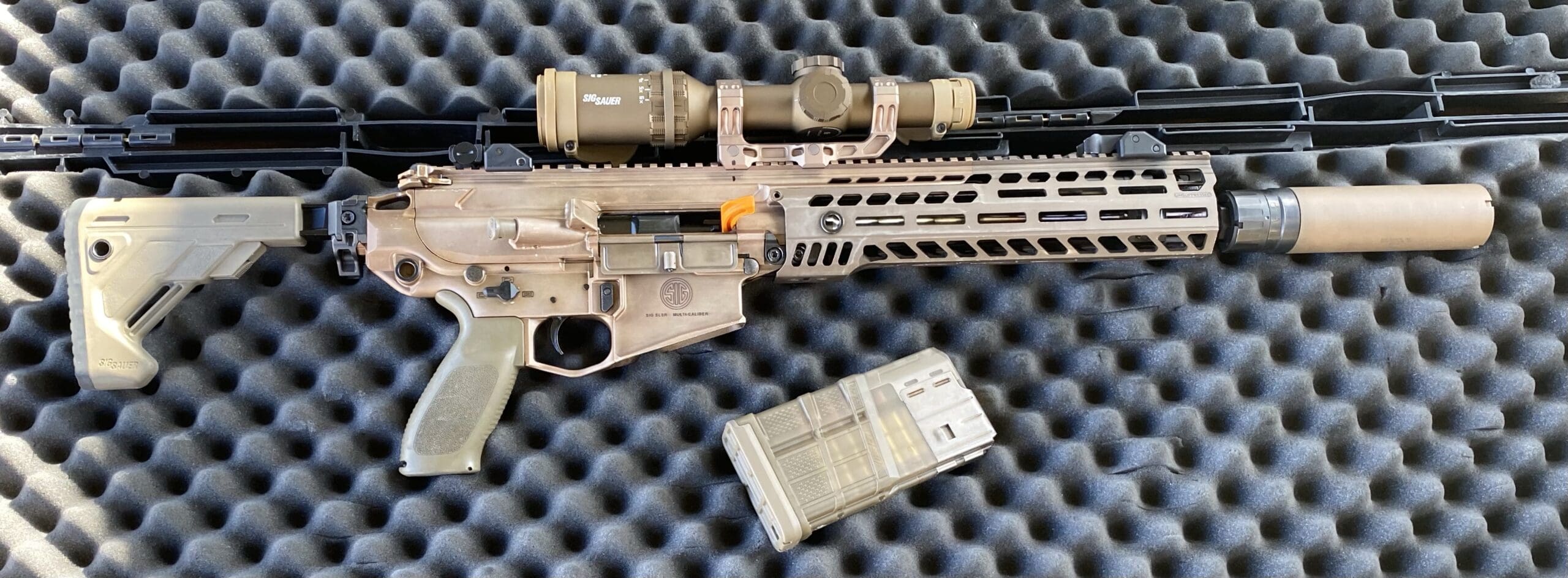
Jason Imhoff also told me that SIG doesn’t plan on stopping with the .277 variant. He foresees a 6.5 and possibly .308 versions of SIG FURY which utilize the hybrid case for higher velocities. Who knows where they’ll go after that.
The Way Ahead
Prototype Test #2 of the Next Generation Squad Weapons program has already begun and the Army will soon make a decision on which candidate system it wants to move forward with. Meanwhile, SIG will continue to refine their hybrid ammunition case technology and offer it to civilian and government customers alike.


I think it’s going to be between Sig and Textron since the manual of arms would have to be rewritten for the bull pup design. Pretty sure Sig will get it since they have proven track record now. Very interested to see where this hybrid ammo will go from here. Hopefully some versions for us mere mortals in the civie world! 🙂
I tend to agree with you. I think that Sig’s design is most likely to get picked up because its the least different from what the Army already knows. Its a significant incremental improvement rather than a total conversion.
quote: “As if it wasn’t enough that the ammunition is a larger caliber than what it is replacing, it has to be at least 20% lighter as well”
This “hides” the fact that it is significantly heavier than the M855A1 it supposedly replaces
There’s no hiding. The Army’s requirement was to lower cartridge weight 20% from an equivalent energy producing cartridge.
The 6.8 ammunition, regardless of which type they select will offer significant increase in range and delivered energy over 5.56. In fact, the new 6.8 machine guns will out perform the M240 in 7.62 as well.
There may actually be a contract awarded to avoid another ar-replacement failure in a long list of them. But, I will eat my hat if this rifle replaces 1/5 of the rifles people are pretending they are going to replace.
The machine guns are awesome, lighter than the M249, lower recoil impulse, longer range.
But the rifles in 6.8 will beat the shit out of you. There’s a huge difference between shooting an AR15 class rifle and and AR10 class. And full auto?
I believe they’ll buy some of the NGSW rifles, but it’s going to be a tough sell on replacing the M4 wholesale, even in the infantry.
What are the odds, do you think, of NGSW evolving into a SDM or sniper support weapon?
I suppose you could, but I’m not sure why you would bother based on the round and optics they plan to field. If it goes like they plan, every rifle would be an SDM weapon.
Isn’t that what the Marine Corps did with the M27, every rifleman is a DM now?
and then…they introduced the M38. But the only thing going on there was a variable power optic and suppressor. Now, every rifleman is getting, you guessed it, an VPO and suppressor.
Possibly, but they’d better get with a better projectile design for longer range… that bullet looks to have the ballistics of a brick – which is great for the application that it’s meant to fill. Granted 80k psi pressure will get you velocity but that’s not the whole picture… heavy-for-caliber is the long-range wave of the future, I think. Plus, bolt carrier life and barrel life is gonna suffer BIG, but that’s a small worry when you’ve got a nearly unlimited supply…
So have you had a chance to fire all three of the submissions for this contract. I know you got to fire the Sig Rifle and machine gun.
I am wondering if felt recoil are the same of the final 3 rifles in the testing? And are you allowed to comment about differences in the three as far as recoil and other things.
No, I have not. The other two companies are keeping their submissions under wraps, at least from me.
A sensible route in my mind would be to take the URGI and chamber it in something like .224 valkyrie or 6.5 grendel but using Sig’s case design. 80,000 psi in either might make for a solid 5.56 replacement. Not that that’s very likely.
Would be cool if Sig came out with a .224 valkyrie fury (boy that sure rolls off the tongue…).
I’m glad to read that SIG is expressly contemplating that this round will be available to the civilian sector. That being said, I would not be shocked if the cost per round would be at least several dollars. I’m also guessing that the unique nature of the case makes it proprietary and as such only SIG would be the source, unless SIG wanted to license the design to another entity?
Also, I wonder what type of barrel life and bolt life is anticipated/expected in light of these relatively high chamber pressures?
SAAMI acceptance means the chamber and case dimensions become public knowledge, by working with SAAMI on acceptance anyone who knows how will be able to cut a chamber or form brass. the hybrid case design may be proprietary though? I’m not sure if that information would be publicly available.
though if the Army does adopt it, they’ll be loading it at Lake City, which means Winchester will know how, again, whether they’re legally allowed too for commercial sale is another case entirely.
Hybrid cases are not proprietary, although SIG may have something on how the two pieces are attached.
IMHO I would think it would be a great deal for Sig to license their ammo and have multiple manufactures meet the standard. Here in Bay St. Louis there is company that already produces hybrid-ammo. Pretty sure the Army would want several places of production as well so there is no bottleneck one source point of failure.
This SIG ammunition can not be the future. It is more complex and consists of different metals. You combine a more and a less noble metal – that can cause creepage current on the surface leading to corrosion. If you then also involve temperature changes and humidity changes over a longer time period… Nature builds perfect things simple. That’s how they should do it.
That’s why there are coatings.
Exactly, there are coatings… another cost factor and I don’t know if they can coat the inner surfaces of the two metals that touch each other and can potentially cause the creepage current. But we will see… It is just my personal opinnion that this complex ammunition has no future in a digital age – this ammo reminds me more on the industrial age of the early 20th century..
Larger caliber was needed, but round needs to simple to manufacture, remember we have our NATO friends to think about, the future is here we have to take advantage of the current technology for better and more effective weapons for our military because one day there will be hand-held laser weapons.
Cartridge weight seems to be the biggest hurdle for SIG vs the other candidates.
The SIG might be lighter then .270 WSM, but its still likely to be close to 7.62×51’s 24g cartridge weight given the materials and cartridge size.
Whereas the Textron and TV cases are likely in the ~16g weight class, making them not just lighter then .270 WSM, but actually comparable in weight to 7.62×39.
Really excited to see where this leads in the future. Focusing on that 6.8 now, but what happens when we apply this to something in the 6mmARC range, say a .257 based on the Valk/SPC case( I know ,I know 6mm more available bullets… but .257 is gonna run better in shorter barrels than 6 or .224) 117@ 2950-3000 from a 16″ gun? Don’t know about you guys but that gets my heart pumping a bit!
If the military goes this routed, where will the civilian reloading market end up over time, I wonder…
With regard to the comment above about coatings, aside from adding even more complexity to an already complex manufacturing process (at least relative to simple brass cases), the coatings themselves add issues, especially over time and extreme usage as would be seen in combat. Further, the issue with the different metals exists in the contact between the two metals, something a simple external coating could not address.
The US Army told industry what it wanted. Industry responded. With this solution, you’re getting lower weight and higher velocities. There are a lot of ways to skin a cat. The US Army did not select a brass cased system because it didn’t meet their requirement. The other two solutions are polymer cased which have their own pluses and minuses. Some armies currently use steel case (even in NATO), and either coat the case or they don’t. They tend to deal with steel issues through chamber design.
As far as reloading. With the SIG system, you can assuredly load your own ammunition using brass case, or if it becomes available, hybrid case. This is not possible with either of the other two solutions the Army is considering. You will need to purchase the TV manufacturing system to work with the GD guns and I remain unsure that the CT technology will be released to the public.
Finally some steps in the right direction regarding ammunition development and a future caliber. 6.8 SPC LIVES!!!!!!
No it most cetrtainly does not. Apart from the bullet diameter this 6.8 has nothing in common with the 6.8 SPC dead end.
This isn’t 6.8 SPC.
This certainly isn’t the 6.8SPC. But never fear fellow 6.8SPC enthusiast! The round most certainly is not dead, and all of the interest in other 6.8 Rounds has injected fresh life into this cartridge. Winchester announced that they would be offering 2 new factory ammos for the 6.8spc. 1 or 2 in the Deer Season XP line (115gr confirmed possible 120gr) and 1 in the USA Ready line (115gr).
Don’t worry about the haters, as long as there are MSR’s there will some following for the 6.8spc. Look how popular the .224 Valkyrie is!
Anyway, don’t sweat it this round seems like it’ll be a smaller cartridge with the performance of the .270win. If that was all they were after, maybe they should have saved a lot of time and effort and just adopted the 7mm-08 LOL
Only time will tell, but I think the sig is a lock. I think the CT ammo is just a bridge too far but maybe someday it’ll come around en masse.
wonder how the barrel life looks like. maybe sig has some new secret in there?
Hehehe… considering that they have serius problems to keep the quality of the Swiss army rifles barrels (Sig 550s) up, i doubt it. The newer production barrels are horrible and have a very short life span. There is a lot of marketing in Sig Sauer – but a lot of deep knowledge is gone because they didn’t care for the older employees and just kicked a lot of them like old dogs… shame
SIG Sauer AG(swiss arms) and SIG SAUER INC. are operationally and organizationally separate companies though they are owned by the same holdings company. SIG SAUER INC is 100% US Based and manufactures all of their own rifle barrels.
Did anyone else notice the M855A1/M80A1 EPR style Army supplied projectile for the 6.8×51?? Whichever submission is picked it looks like that round will need to be added to the NIJ 0101.07 proposed body armor standard for RF2 and RF3. I see a round with high BC, screaming high velocity and right construction that MAY be able to punch through your average Level IV plate as is (Add in a tungsten version of the EPR and you have a Level IV killer).
Throw those Level III plates away folks. They will do you no good.
So you’re saying the gun-grabbers and other left wing kooks won’t have to make buying plates, armor illegal? They will just shoot us at our front door or use a hellfire. Can’t hardly wait! 🙂
The whole reason for the 6.8 Army was to develop standard service weapons that destroy targets wearing body armor, out to 500 meters
Pretty sure I saw that L3/Harris optic on a Rebel heavy blaster used on the Hoth system. Any glimpse of the reticle on either one?
They are only showing mockups of proposed chassis. That program is behind NGSW. My confidence in it being fielded 1:1 for all NGSW weapons is low. Maybe on the MGs but it’s too heavy and expensive for the rifles.
The Sig option is not as sexy as the Textron or GD options but as long a barrel life works it is a practical lower risk option. The NGSAR is not intended for use by the whole force, 5.56 M4 will still be a primary weapon. If adopted for 1/5 of our troops would Sig uppers be an option for updating the M4 supply? MCX Virtus and Spear are very similar for training purposes. 5.56 would still be in the supply pipeline. An eventual 5.56 hybrid with higher case pressure/velocity would also solve some of the short barrel lethality issues with current M4 type rifles. Going the SIG route would seem to offer low risk solutions on many levels.
It is interesting to note that the GD option is now being marketed as recyclable. I know that tree huggers are not popular here but you have to think about generations of cases being left all over the world. Micro plastics in our water supply is a huge issue. One of the benefits of SIG was the cases would eventually go away. Brass is also recyclable.
I wonder if the dissimilar metals will cause corrosion on the ammo over long term storage?
The 6.8X51 would also be an easy conversion of already 7.62 NATO rifles with a barrel swap and maybe the BCG.
The telescoping ammo that is touted by other submitter may be lighter but it would also be bulkier taking up more room for the grunt in the field.
I might have to eat some crow on this… When Sig announced the .277 Fury it was marketed as a result of these efforts but not the final round. Now it looks like they are going with the .277 Fury as other sources have called it the 6.8 X 51.
If this is truly the case (which it looks like it probably is). I am a bit kerfuffled. Again, assuming this is correct, the .277Fury is seems to have the performance of the .270win not the .270wsm which is 250-300fps faster.
In any case, glad to see Sig making lots of .300wm ammo, makes it cheaper and more available to me. Good work folks at Sig!! Keep it up!!
I have only seen True Velocity use the term composite cased ammunition, and Sig use Hybrid. Is Sig just rebranding or is this a typo. How is using two metals considered to be composite? Here’s an article from August 2020 with True Velocity using Composite
https://www.tvammo.com/delivers-next-gen
And Soldier Systems’ original article using Sig’s Hybrid.
https://soldiersystems.net/2021/02/02/sig-sauer-completes-final-delivery-of-next-generation-squad-weapon-system-to-u-s-army/